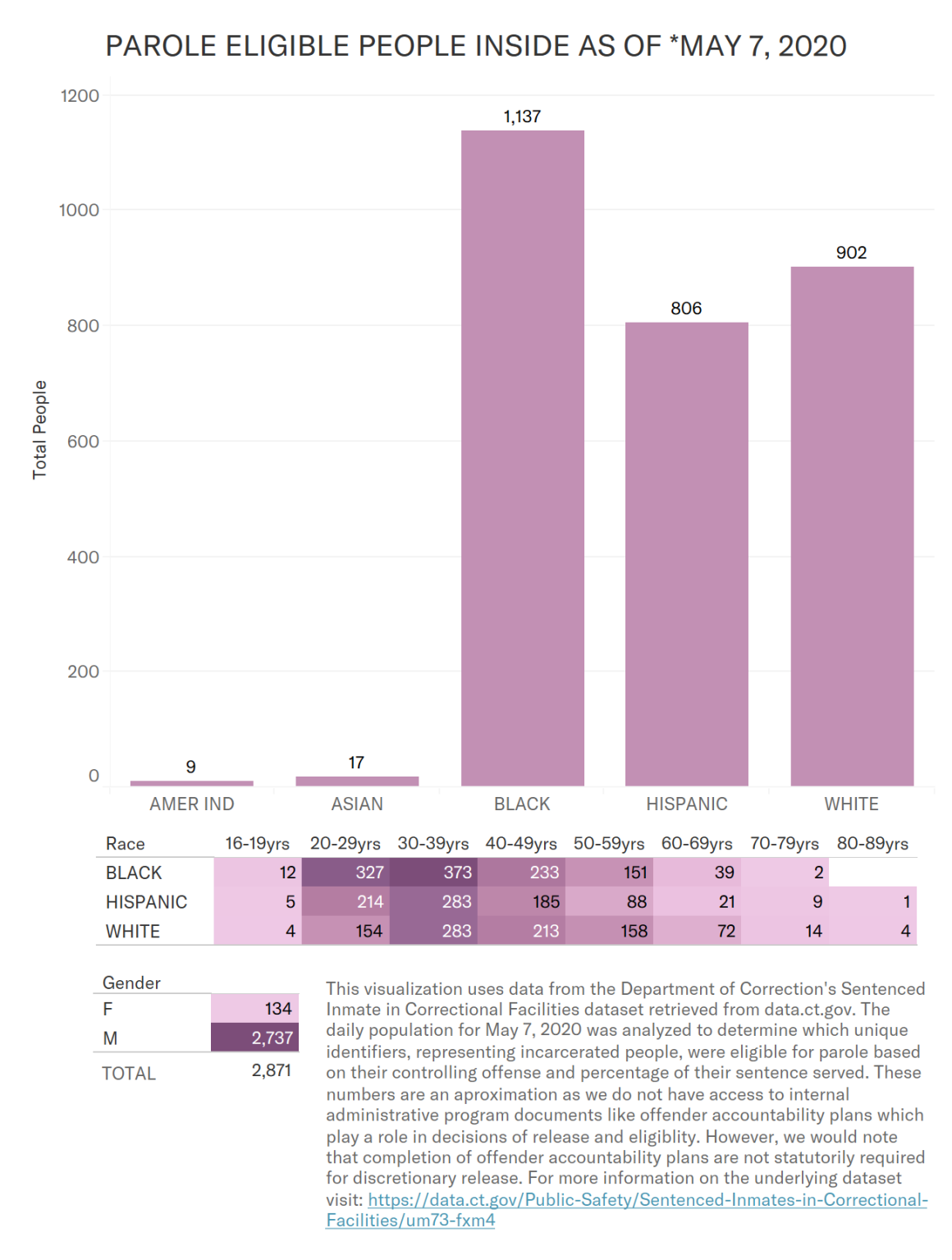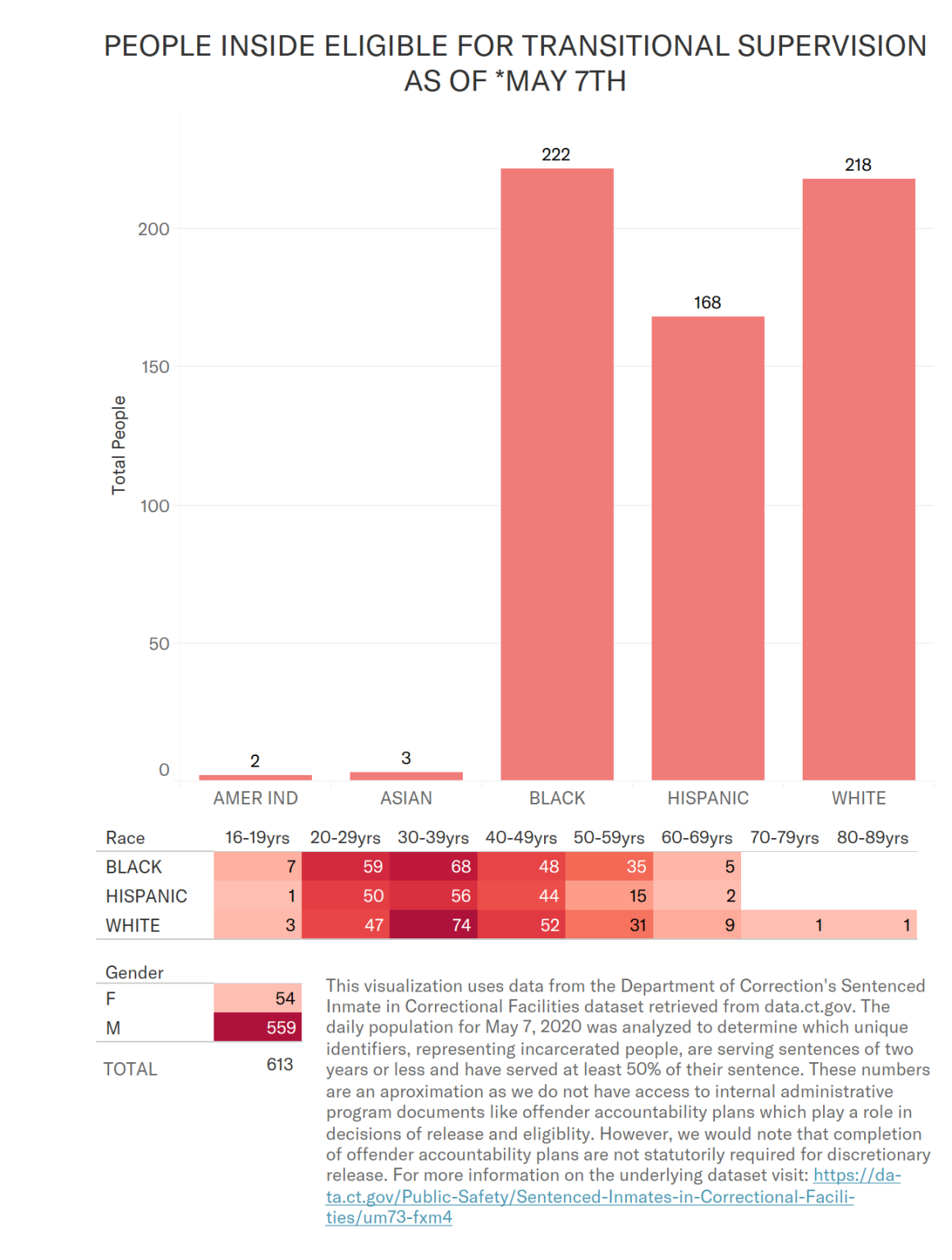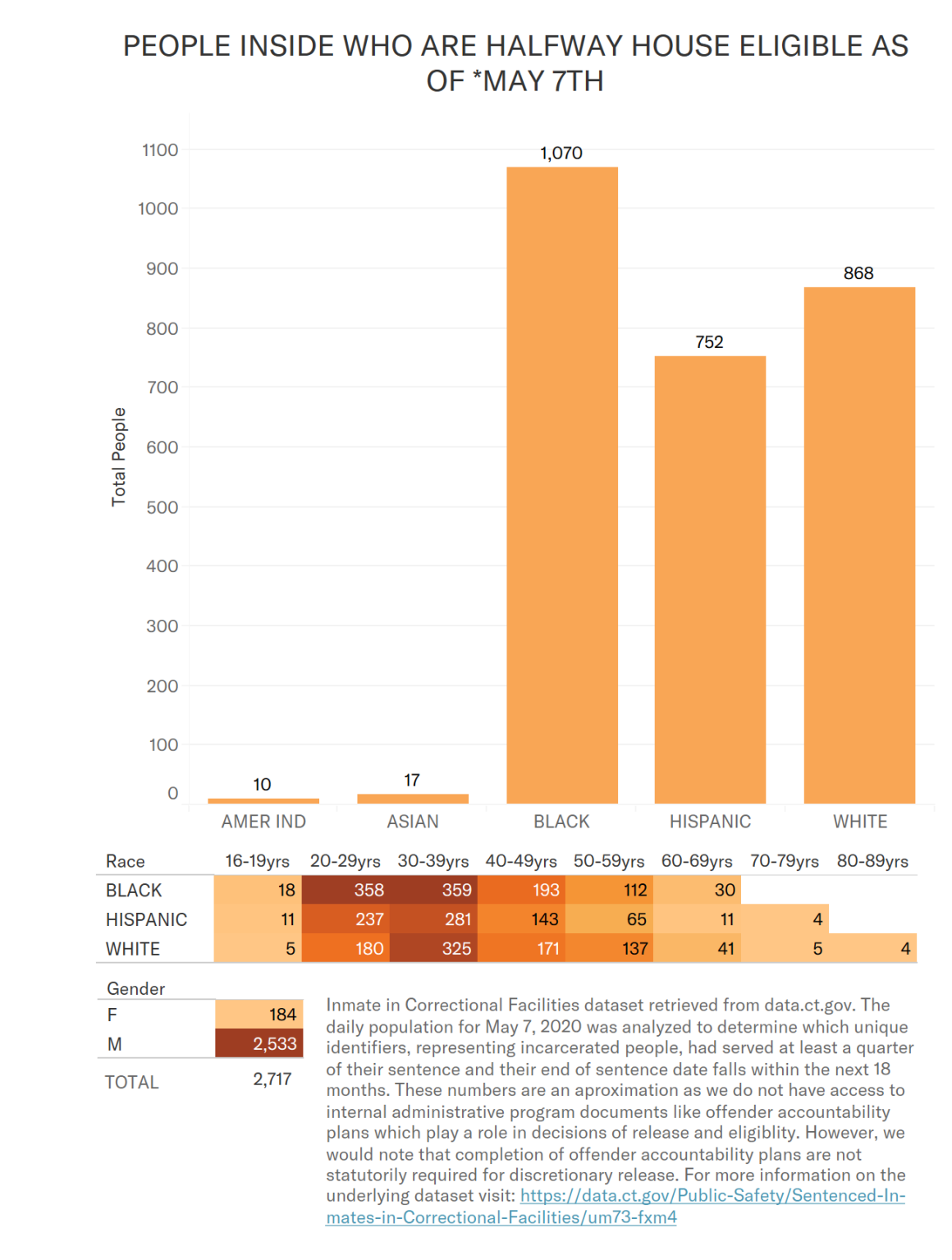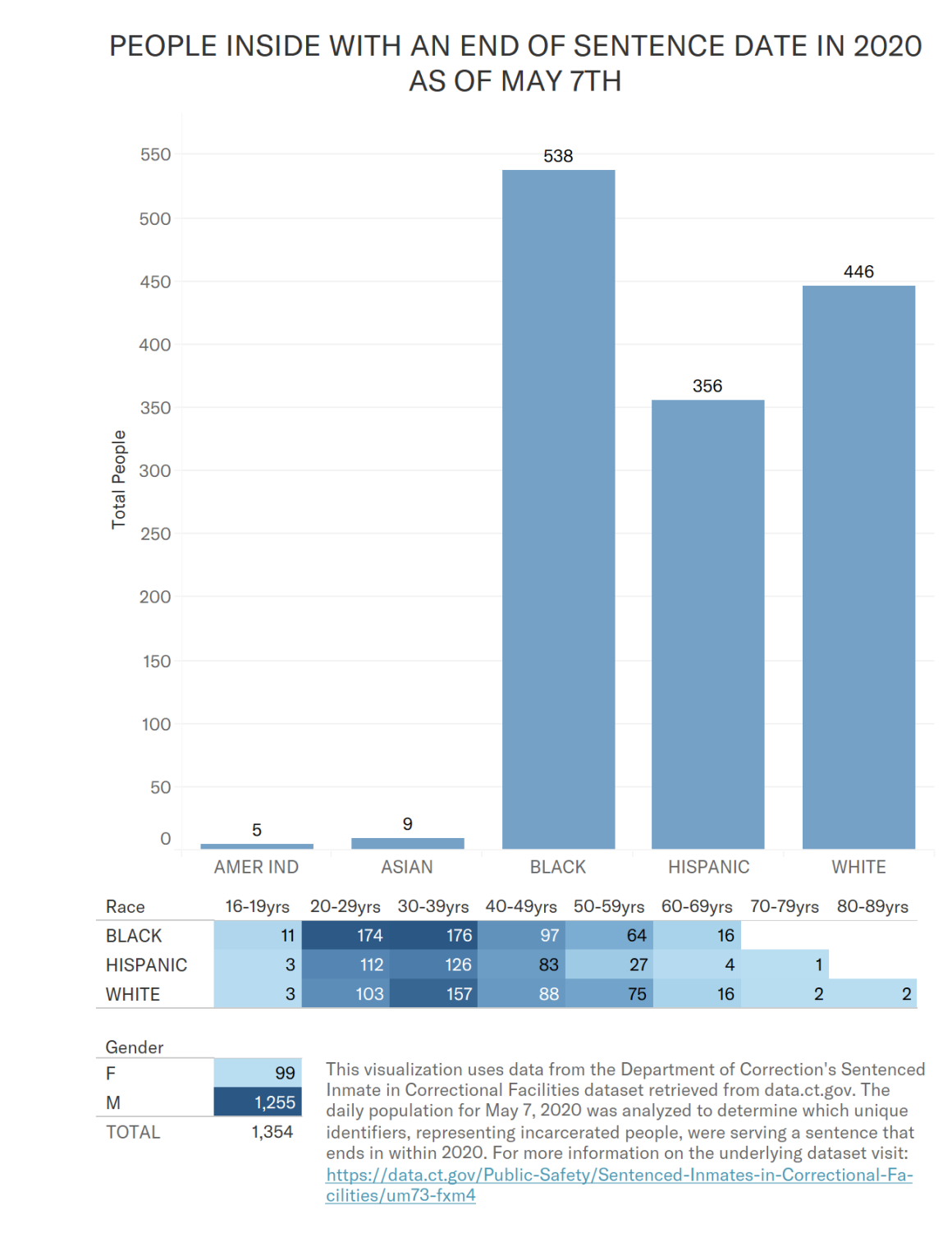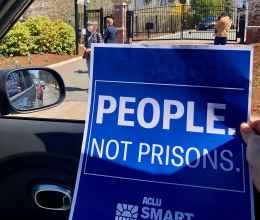
Since the outset of COVID-19 hitting Connecticut’s prison and jails, Governor Lamont and his administration have not clearly and transparently described a position or plan for prison releases. In fact, during one of Governor Lamont’s daily briefings in late March, the Governor stated there would be no releases of incarcerated people. Yet now, facing pressure from families and other constituents and lawsuits in the courts, the Department of Correction (DOC) and Lamont are attempting to re-brand the DOC’s lackluster release numbers. The numbers that Lamont and the DOC once said weren’t indicative of a COVID-19 response? Now, the DOC is trying to say they are.
So, what’s actually happening with releases in Connecticut? We looked at the numbers, and they show the DOC’s releases reflect a business-as-usual approach that is leaving many people in harm’s way during a pandemic. And the majority of people being left behind are Black and Latinx.
A Steady Habit of Releases
What is a “Discretionary Release?”
If the state was responding to a global, rapidly spreading pandemic by using its power to release people from prisons, one place to look (of many) is at its “discretionary early releases.”
Also known as “discretionary releases,” a “discretionary early release” is the early release of a person from incarceration prior to their end of sentence date. Within the world of criminal justice policy, “discretionary early release” refers specifically to sentenced people who qualify for supervised release to Connecticut communities. Discretionary releases move people out of prisons and into the community (in Connecticut, “release” almost always includes being released with supervision conditions, like parole). Notably, discretionary releases don’t include people who are being held pre-trial; people who are innocent unless proven otherwise don’t have an end of sentence date, because they don’t have a sentence at all.
If the DOC was moving people in its sentenced community out of harm’s way, discretionary releases would be a way to do so (there are plenty of others, including, critically, releasing people who are being held pre-trial). For the sake of argument, we are going to take a look at discretionary releases, but it’s important to remember that discretionary releases are one of many tools in a much bigger puzzle, and that they don’t pertain to nearly 3,000 people who are incarcerated in Connecticut right now: people being held pre-trial.
Discretionary Releases are Common
Discretionary releases are common business for the state’s correction system. They were happening in March before the pandemic hit Connecticut, and discretionary releases have been happening every month since the formation of Connecticut’s unified correction system in 1968.
Governor Lamont inherited an era of decarceration. Connecticut has been reducing its prison population for 10 years. At the same time, its crime and arrests rates have both gone down.
Connecticut has received national attention for its overall prison depopulation in part because of former Commissioner Scott Semple’s innovation in centralizing discretionary early release decisions within the Community Release Unit (CRU), giving the DOC Commissioner a streamlined way to create widespread releases if they chose. According to OPM’s monthly indicator reports, since the creation of the CRU in March 2015, it has averaged 370 discretionary releases per month. Prior to the creation of the CRU, the Department of Correction averaged 467 discretionary releases per month, going back to 2010.
So, the question is not whether discretionary releases are happening in Connecticut – discretionary releases have been part of the Connecticut DOC for decades and are core to the agency’s reentry model. The question is also not whether staff at the CRU are hard at work to place people in community supervision programs – we are sure they are.
The question is also not whether the DOC can effectively manage a global pandemic in its facilities – it can’t. Connecticut prisons are not healthcare facilities, nor are they healthy places.
The question is: will Lamont and the DOC significantly, urgently increase discretionary releases to protect public health and save lives during a deadly pandemic that is dangerous for everyone, especially people in congregate living facilities – places like prisons and jails? And, given that people in those prisons and jails are more than two-thirds Black and Latinx, will Lamont and the DOC increase discretionary releases to save Black and Latinx lives? Lamont and the DOC’s answer to both questions so far has been no, and recent numbers bear that out.
Steady Habits, Not a Sufficient Pandemic Response
March 2020 Discretionary Releases: Business-As-Usual Numbers and Ratios
We are hearing constantly from incarcerated people and their loved ones about requests for release that have been denied by the DOC during the COVID-19 pandemic – including people who were set to be released to halfway houses, people who were denied because they hadn’t finished a program that isn’t being offered during the pandemic, people who have family members and safe housing to go to, medically vulnerable people, and more.
But recently, an agency within the Lamont administration – the Office of Policy Management (OPM) Criminal Justice Policy & Planning Division – released a monthly indicator report that claims March 2020 showed “the most discretionary people released from correction facilities to the community without supervision.” Given that furloughs (15 in March) and nursing home (0 in March) releases are the only discretionary categories that do not impose supervision, it is extremely unclear what OPM meant.
The report also contains unclear and contradictory information about how many people were at the end of their sentence when they were released from DOC facilities in March. Remember, someone being released at the end of their sentence is not a discretionary release – they were supposed to be released regardless of a pandemic. The report claimed that only 237 of 506 people were at the end of their sentence when they were released from DOC facilities in March. But this contradicts the DOC’s own population dataset, which shows that on March 1, 337 people were housed in DOC facilities with an end of sentence date that would likely result in a March release. Looking at the data, we were able to track 336 people in DOC facilities who were removed from that same DOC population dataset during the month of March, who did not have a special detainer and were not on special parole. [Note: OPM did not provide the methodology or specify which dataset it used to create its chart (Chart 2a), so we could not recreate its results.]
In other words, it’s possible that OPM is underreporting the total end of sentence releases from DOC facilities. If it is underreporting, then it may be that close to 7 out of every 12 people released in March were discretionary releases, not 7 out of 10 as reported by OPM.
“Mr. Rodriguez is eligible for halfway house placement in May, but has been told by DOC that no one will be released to a halfway house during the COVID-19 pandemic.” – complaint in CCDLA v Lamont
If so, March’s discretionary release ratio roughly matches the ratios we’ve seen in past monthly indicator reports as recently as December 2019, before the pandemic appears to have reached Connecticut. In fact, using our end of sentence release numbers, we found that 10 out of the prior 26 months in OPM’s monthly reports show the same release ratio as March 2020. In other words, the discretionary release numbers being reported by the Lamont administration seem to show regular business, not a pandemic response. [Note: OPM reports a 72% increase in discretionary releases between February 2020 and March 2020, however, it failed to mention that February 2020 – before COVID-19 appears to have reached Connecticut – had the fewest monthly discretionary releases reported dating back 10 years.]
There are a few things missing from the OPM monthly indicator report that are also critically important for understanding what’s happening with releases. Equally important to the total number of discretionary releases is the number of days or months that people were discharged from prison in advance of their end of sentence date. Measuring end of sentence discharges from DOC facilities is an important data point that would provide a clearer picture of the DOC’s overall COVID-19 release response. The DOC goes out of its way in a FAQ document to include end of sentence discharges as part of its COVID-19 response, writing, “The Department of Correction continues to review and release eligible and suitable low-risk offenders with a verified housing plan before their end of sentence.”
As “continues” underscores, though, releasing people before the end of sentence is a business-as-usual approach for the DOC – the question is whether there has been an urgent increase in pre-end-of-sentence releases, befitting a global pandemic in which people are especially at risk in DOC custody.
After all, it is impossible to practice physical distancing in Connecticut prisons, and the DOC’s prison system has the worst infection rate when compared to Connecticut cities and towns. Unnecessarily keeping people in prison and jails who are on the cusp of release has already had dire and irreversible consequences.
We tracked 336 people (excluding special detainers and special parole) in the DOC’s sentenced population dataset with an end of sentence date requiring their release in March. We found that 68% of those releases happened on or after their release date, 26% within 4 days of their release date, and only 5% were released 6 days and beyond.
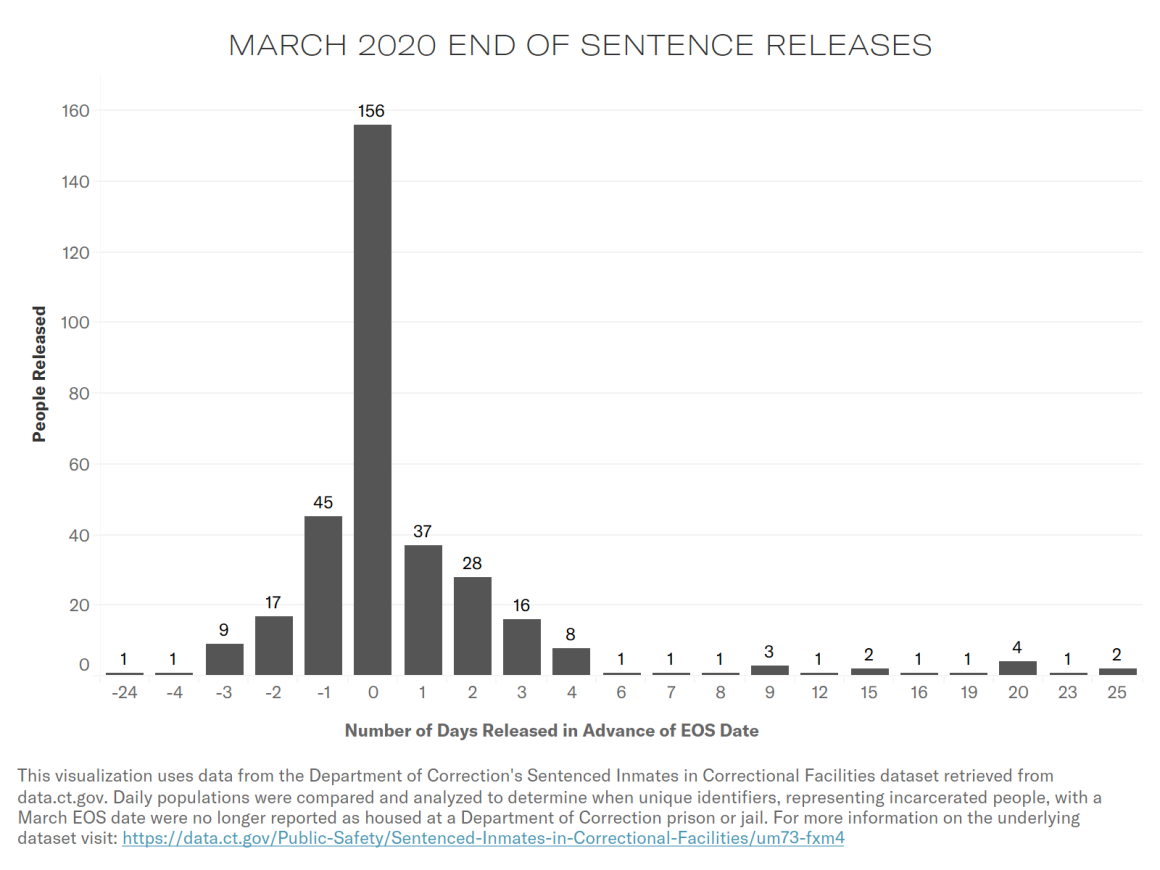
Our findings on March end of sentence releases call into question whether the DOC has a COVID-19 response release plan at all, and whether Governor Lamont has properly resourced the agency to effectively, quickly, and safely release people to get them out of harm’s way during the pandemic.
Again, these numbers only consider releases among people who were sentenced. There are thousands of people who are being incarcerated pre-trial in Connecticut, who have not been convicted of a crime and who therefore do not have any sentence to serve. The DOC only mentions these people once in its “COVID-19 Release” FAQ – and only then, to mention the number of “intakes” (people brought in pre-trial), not people released.
March 2020 Discretionary Releases: Low, Compared to the Last 10 Years
Recently, the DOC boldly claimed on Twitter that the month of March “showed the greatest number of DOC discretionary releases on record.” Again, having heard the stories from families denied their requests for the DOC to release their loved ones, we were skeptical but curious.
We wanted to know: how do March 2020 releases measure up to other months during Connecticut’s 10-year-long decarceration era? How do March 2020 Community Release Unit releases measure up to other months in the Community Release Unit’s 5-year history? How do March 2020 releases measure up over a 3-year period? Did March 2020 show “the greatest number of DOC discretionary releases on record?”
So, we went back and grabbed discretionary release data from every OPM monthly indicator report dating back to April 2010 and plugged the data points into a table.
We ranked the results individually for each discretionary mechanism, for total discretionary releases, and for discretionary releases that only the DOC through the Community Release Unit has the authority to grant. To match OPM’s definition of “discretionary releases,” we also excluded special parole releases.
According to OPM’s data, the DOC’s statement is false. Even if you include parole releases, discretionary releases in March 2020 are nowhere near “the greatest number … on record.”
Overall, excluding parole and transfer parole, the DOC’s March 2020 discretionary releases measure up to 57th overall in monthly releases during the era of decarceration (in the past 10 years). Including parole and transfer parole releases sets it back to 65th overall in monthly releases during the era of decarceration.

Perhaps the DOC meant greatest number over the last 5 years since the creation of the CRU? Nope, looking at the past 5 years, March 2020 discretionary releases, excluding parole and including parole, measure up to 14th overall and 15th overall, respectively. Perhaps over a 3-year period? Nope, March 2020 discretionary releases measure up to 4th overall, including and excluding parole.
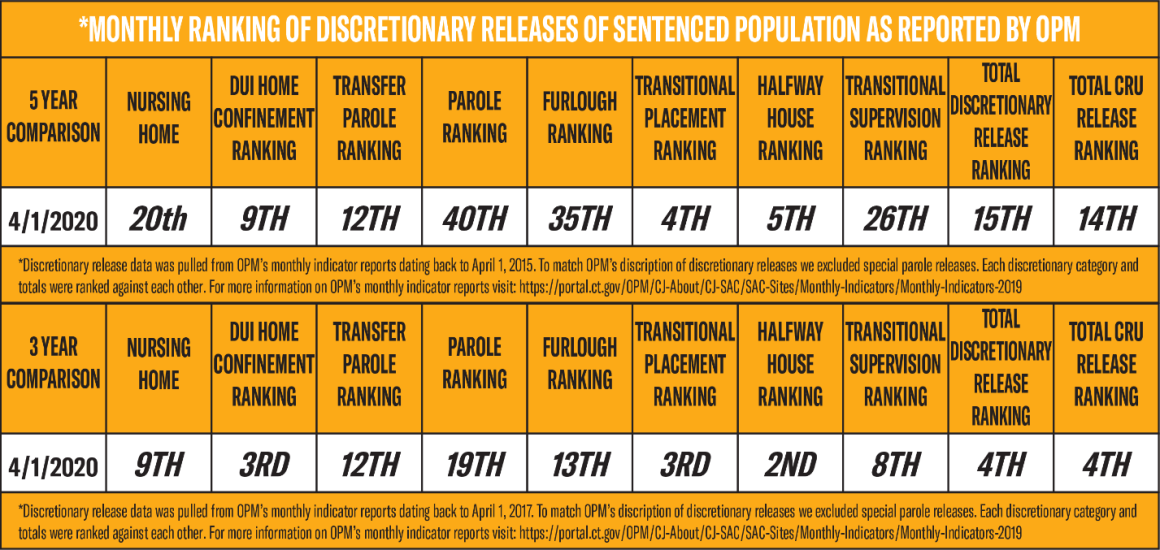
To be sure, one wouldn’t expect a big ranking jump in categories involving releases to other proximate living facilities like nursing homes right now, but the vast majority of these categories don’t involve those situations. And certainly, the population was larger in Connecticut ten, five, and three years ago (which would mean a greater number of people to potentially release). But those were also not the time of COVID-19, when the extraordinary danger to people in prisons and jails would, one expects, be reflected by an extraordinary number of releases.
March 2020, in other words, should show up as more than a blip on the releases radar. Right now, it doesn’t. Years from now, when someone looks back at the discretionary release numbers from March 2020, the month the COVID-19 outbreak seems to have begun inside, it will look like a fairly normal month in the span of Connecticut’s 10-year decarceration history – and that, in and of itself, shows that the DOC’s releases aren’t indicative of a COVID-19 response. [Download the release ranking data here]
In its FAQ, the DOC even admits that its discretionary release numbers are not extraordinary despite these extraordinary times. The DOC claims that its March discretionary release numbers were “more than every previous month dating back one full year.” If true, that means there was at least one month in the past year, during the normal times before COVID-19 in Connecticut, when the DOC was releasing more people than it did in March – during a deadly global pandemic that is killing and sickening people in DOC prisons and jails.
“A lot of people who are close to the end of their sentences come and talk to me. I would guess that right now, in my dorm, there are about 20 people who are within 60 days of their end-of-sentence date ... DOC has the discretion to release the people on furlough when they are at the end of their sentence. Our dorm is at nearly full capacity, and there are many people who are near the end of their sentences, but not one has been released on furlough.” – C.P., affidavit in McPherson v Lamont
To be clear: the less time someone spends in prison or jail right now, the better. It’s good that some people have a better chance at protecting their health because they have been released from Connecticut prisons and jails. It’s good that 336 people who had already earned their chance to return to society were released on time, slightly early, or close to on time.
It’s dangerous and disingenuous, though, for the Lamont administration or DOC to try to mischaracterize what those release numbers actually show. The release numbers coming out of the DOC don’t show a coordinated, thoughtful plan to safely, urgently release people to de-densify prisons and make healthcare, hygiene, cleaning, and physical distancing possible during a global pandemic unprecedented in modern times. They do show a slow trickle of some people being released, 39% of whom were scheduled to be released anyway in the month of March. And those numbers don’t tell us anything about people who are being incarcerated pre-trial.
As it turns out, there are also severe racial disparities in who the DOC seems to be releasing, and who it is leaving in harm’s way in prisons and jails.
The DOC’s Releases are Leaving Black and Latinx People Behind
Public health evidence from the COVID-19 pandemic suggests that people in congregate living settings are at high risk of infection. The Connecticut DOC’s prisons and jails are congregate living settings in which, as of April 1, 2020, 70% of people living there are Black or Latinx. In fact, Black and Latinx people have made up the majority of the DOC’s prison population for at least the last 30 years. And while Connecticut has had a steady habit of discretionary releases throughout the DOC’s history, it also had a steady habit of incarcerating Black and Latinx people are a higher rate than white people.
According to a recent presentation from the Lamont administration’s OPM, white incarcerated people made up 38% of DOC discretionary releases in March, despite making up only 30% of the total sentenced population at the beginning of March. Black & Latinx incarcerated people made up 69% of the total sentenced population at the beginning of March but only 62% of discretionary releases during a global pandemic.
The Lamont administration and DOC have not issued a public plan for compassionate, thoughtful, safe releases, so there is not a document for us to analyze the policy drivers of this racial disparity. But there are some hints.
In its FAQ document, the DOC states that an objective computerized system automatically identifies eligible incarcerated people for review. One could easily read this statement to mean that the DOC is running an algorithm that identifies an eligible population, independent of human input. However, we could not find evidence that such a system exists.
In fact, the DOC’s description of the CRU discretionary release process directly contradicts what the DOC describes in its FAQ document. The CRU process is entirely driven by DOC staff. DOC facility staff are responsible for identifying people eligible for release; facility staff are responsible for preparing materials required for a CRU release decision to be rendered; facility staff are responsible for submitting the materials to CRU electronically, and CRU staff review the materials and render a decision. Per the DOC’s own description, every step of the discretionary release process is driven by staff, not an automatic computerized system.
In other words, there is subjectivity every step of the way in the DOC’s releases. Releasing less Black and Latinx people than their overall percentage of the sentenced community in the month of March, during a global pandemic, should at the very least cause the DOC to review its process for the potential of implicit bias.
In its FAQ document the DOC acknowledges that it is using its normal procedure for determining discretionary releases. This means that during the pandemic, the DOC is relying on an existing system that, despite critical decarceration reductions since 2015, has not made a dent in reducing racial disparities in the past. Without a clear plan, there can be no racial impact analysis. With no racial impact analysis, the DOC risks exacerbating existing racial disparities in its incarcerated community.
Governor Lamont and the DOC have also repeatedly stated that they will only release people who have a “verified housing plan.” But for a variety of reasons, the DOC and Lamont’s requirement of a housing plan is likely not a race-neutral policy choice. Due to systemic racism and discrimination, Black men and women are most likely to be housing insecure after incarceration.
Housing is a human right, and no one wants people to be released into homelessness, or to create crowding in shelters. But a prison or a jail is not a healthy home, either – and prisons and jails are particularly unhealthy places during a pandemic. As family members of incarcerated people have repeatedly tried to tell Lamont, many people inside have homes and families who want to take them in.
“I have a house to go to. I have a home where my fiancée has never been in trouble, in Connecticut, and a job waiting for me.” – Z.H., affidavit in McPherson v Lamont
During the pandemic, the DOC has denied medically vulnerable people for release when they had homes to go to, including with disastrous results. As one housing advocate has pointed out, the amount that Lamont has allocated to fund reentry support is also “a drop in the bucket.”
No matter the intent or reason for the racial disparities in releases so far, the effect – racial disparities in releases – is unjust.
Furthermore, these racial disparities don’t exist in a vacuum. Mass incarceration is just one example of the detrimental effects of structural racism on Black and Latinx people. Connecticut has not reduced the racial disparities it cemented in its prison population during the mass incarceration era. Prisons are not healthy places, and there are strong and pervasive links between incarceration and multiple adverse health indicators over a person’s lifespan and their family. [Note: See Massoglia M, Pridemore WA. Incarceration and health. Annu Rev Social. 2015;41:291-310. See also, Fazel S, Baillargeon J. the health of prisoners. Lancet 2011; 377: 956-965. See also, Wildeman C, Wang EA. Mass incarceration, public health, and widening inequality in the USA. Lancet. 2017; 389: 1463-1474.]
And today, because of decades of systemic racism embedded in the criminal legal system, the majority of people in Connecticut prisons and jails, in harm’s way during the COVID-19 pandemic, are Black and Latinx people. It is clear that saving incarcerated people’s lives from COVID-19 requires centering policy choices on racial and ethnic impact.
We don’t know if Governor Lamont plans to release Black and Latinx incarcerated people at a rate proportional to their overall makeup of the prison population or higher. We also don’t know if Governor Lamont understands that every decision he makes around incarceration during the COVID-19 pandemic is a choice that disproportionately affects Black and Latinx lives. Governor Lamont hasn’t addressed this issue, and that speaks volumes.
Who is the State Currently Leaving Behind?
A Look At People Who Are: Elderly, Medically Vulnerable, Black and Latinx, Sentenced and Eligible for Release in 2020
As illustrated by the racial disparities outlined above, another critical way to look at the DOC’s discretionary releases to date is by asking: who is the DOC leaving in harm’s way by keeping them incarcerated during the COVID-19 pandemic?
And, how many of those people are older than 50 (a medically high-risk category), medically vulnerable (another medically high-risk category), already eligible for some form of discretionary release, or there with only a few months left on their sentences?
COVID-19 can be dangerous for people of all ages and walks of life. Medical and public health evidence also suggest that people over the age of 50 face a greater risk of serious illness or death from COVID-19, and that people of any age are at an elevated risk if they suffer from certain underlying medical conditions. Evidence also shows that the close proximity, lack of hygiene and cleaning, poor ventilation, and lack of medical care in prisons and jails makes them dangerous for people living and working inside.
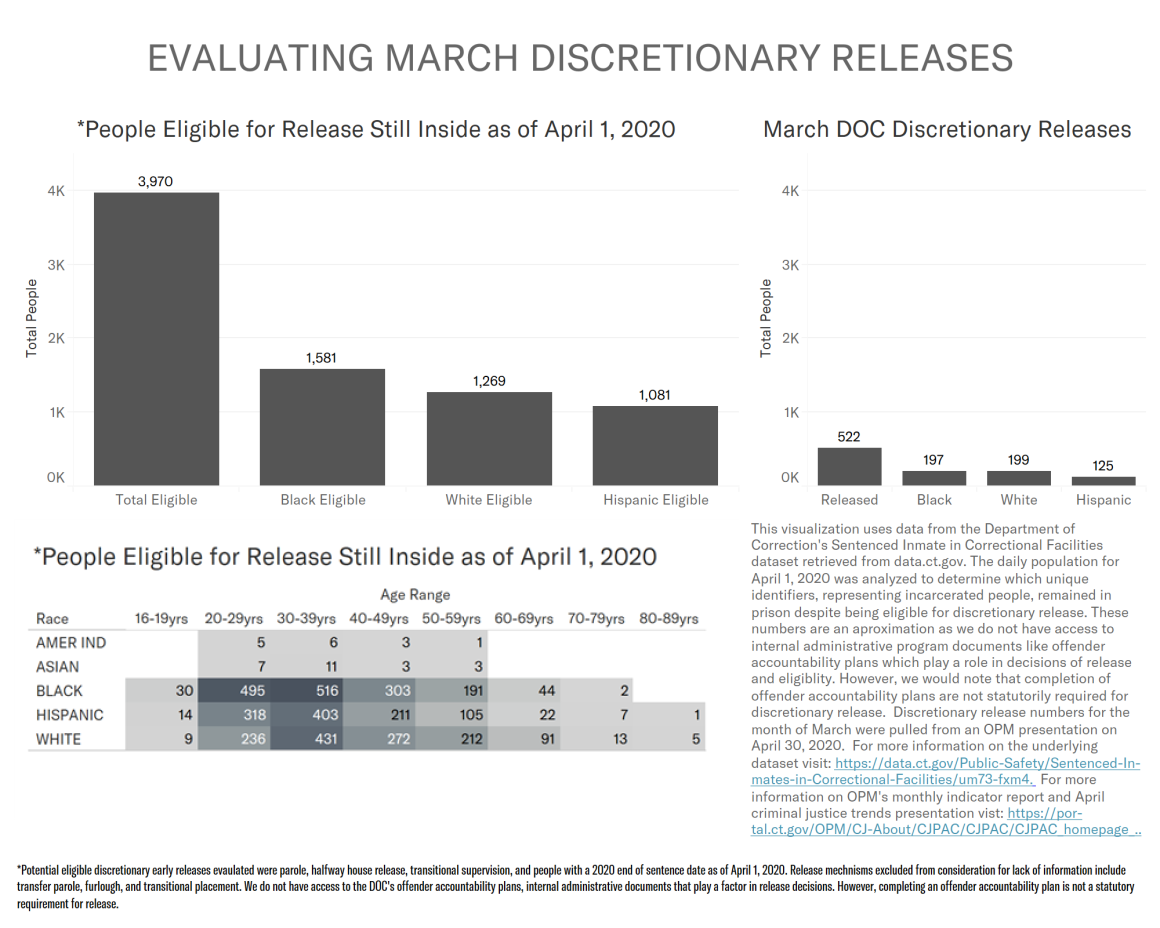
How Many Older People Is the State Leaving Behind Right Now?
We started by looking at how many older people who are already eligible for release in 2020 are being left behind by the DOC’s non-response to COVID-19. The high risk presented to older people is especially true for people in prisons and jails, not just because of the risky conditions inside but also because public health experts have found that “prisoners’ physiological age averages 10 to 15 years older than their chronological age.” Again, discretionary releases only involve people who are serving a sentence of incarceration – which does not include the thousands of people who are incarcerated in Connecticut right now without being convicted of a crime.
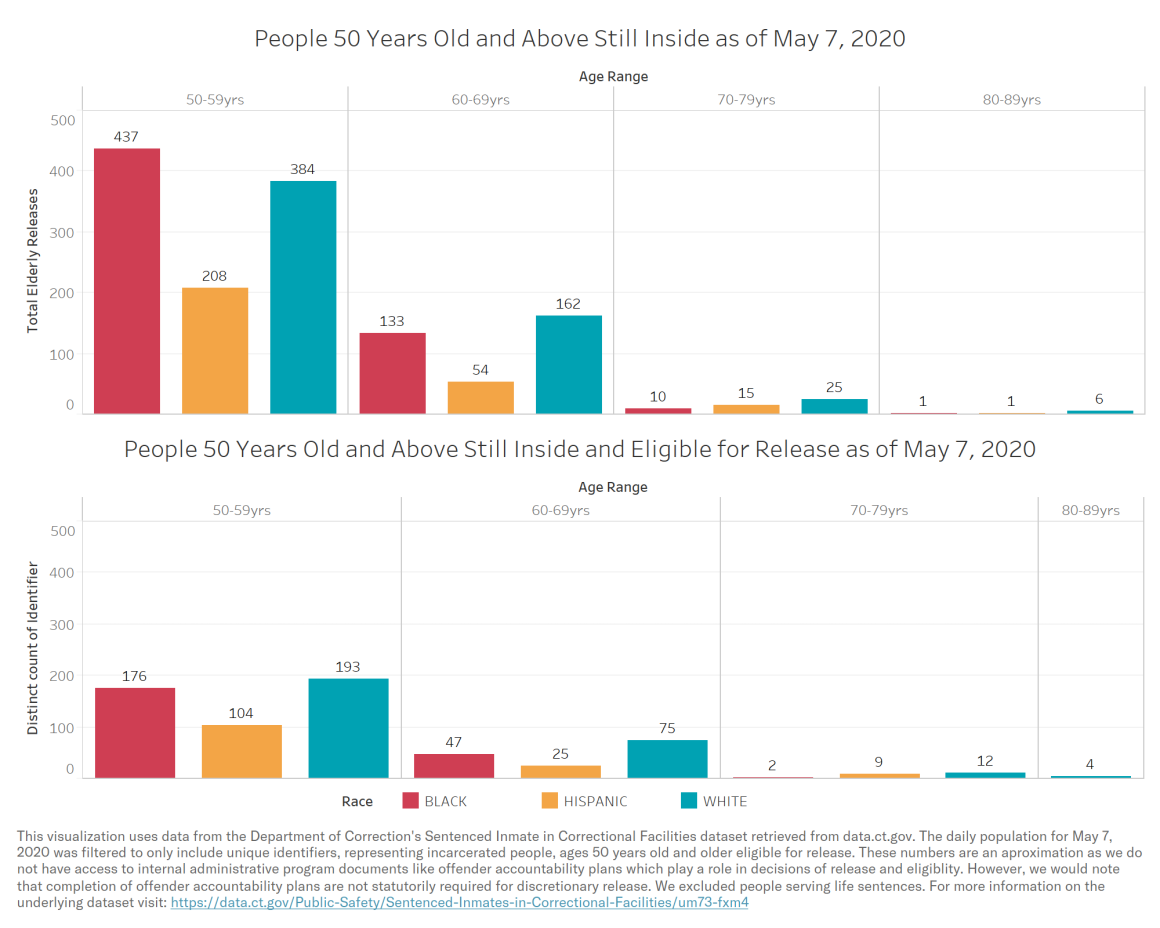
As of May 7, 2020, the DOC was continuing to incarcerate more than 1,400 people age 50 and over, excluding people who are serving life sentences. We then filtered the elderly population for incarcerated people that qualified for some form of discretionary relief as of May 7, 2020. We found that of the 1,450 incarcerated people age 50 and over, 652 were eligible for some form of discretionary relief as of May 7th. The majority of those 652 people were Black or Latinx. Put another way, despite public claims by Lamont and the DOC that they are prioritizing people 50 and over for release, as of May 7, more than 600 people from that age group remained incarcerated as of May 7 despite being qualified for some form of discretionary release. Yet during COVID-19, every effort should be made to protect elderly incarcerated people from the virus by releasing them from DOC facilities.
While our results are an approximation of who could be eligible, the potential racial disparities in who would be left behind among older people also show why Lamont’s inaction to date is especially troubling. Using the existing discretionary release mechanisms that the DOC has in its control, within the age range of 50-59 years old, only 40% of Black incarcerated people still inside would be eligible for release as of May 7, 2020 compared to 50% of white and Latinx people. Similarly, within the age range of 60-69 years old, only 35% of Black incarcerated people still inside would be eligible for release as of May 7, 2020 compared to 46% of white and Latinx people. Lamont has the authority to use his emergency powers to widen releases of people age 50 and over to protect more than 45% of elderly people inside who are left behind, who are disproportionately Black and Latinx. A business-as-usual approach to releasing the elderly incarcerated population is one example of why an intentional effort to center racial impact will require a coordinated and thoughtful plan.
How Many People Who Appear Qualified for Release Are Being Left Behind by the State?
Another way of looking at who the DOC is currently leaving behind is by looking at how many people seemed qualified for release, based on available data, but were not released. The numbers show that nearly 4,000 people seemed to qualify for some form of discretionary relief as of April 1, 2020, but remained incarcerated as of that date.
“I have been approved for release to a halfway house since October 16, 2019, but now I have been told that the halfway houses are not accepting people from prison, so I can’t be released to one. I know I committed a crime, and that’s why I’m here. But I also feel like I earned my release date ... If they let us go, like they are approved to do, it would make more space for everyone else, and the other prisoners and the staff would be safer. Right now, I feel like I am just sitting here waiting to get sick, and there is nothing I can do to protect myself.” – K.P. in affidavit in McPherson v Lamont
As of May 7, 2020, there were 2,871 people left behind inside who could have been eligible for parole by that day. The Board of Pardons and Paroles controls parole releases, and its March parole release numbers are lackluster – 91st most number of releases in the past 10 years, 40th in the past five, and 19th in the past three. Of all existing discretionary release mechanisms, release on parole would have the largest impact on the elderly incarcerated population (559 people); as discussed earlier, though, Lamont could also be using his authority to prioritize these releases.
Another discretionary release mechanism, halfway house release, is controlled by the DOC. As of May 7, 2020, 2,717 people were left behind in DOC facilities who would have been halfway house eligible that day. One natural limitation of halfway house release is capacity. Currently, DOC contracts with community partners limit bed availability to a little over 1,000. But the DOC has discretion, through a mechanism called “transitional placement,” to move people in its halfway house population into alternative living arrangements through an approved community placement or private residence, which could open up options to families and others to have their loved ones come home.
How Many People with Little Time Left on Their Sentences Are Being Left Behind By the State?
Another way of looking at who is being left behind by the state’s current release approach is by looking at how many people remain inside who have sentences ending soon – trapped inside during a pandemic despite being very close to their release dates. Nearly 1,400 people incarcerated in Connecticut right now have sentences ending sometime in the next seven months (by the end of 2020), and a little more than 600 people inside are serving sentences of two years or fewer.
Just as with the older population, those left behind are majority people of color. Of the people who are already eligible for release in 2020 but remain incarcerated as of May 7, just under 67% are Black or Latinx.
How Many Medically Vulnerable People Are Being Left Behind by the State?
Finally, data about how many medically vulnerable people are in Connecticut prisons and jails isn’t easily accessible, making it hard to gauge how many medically vulnerable people are being left behind by the state right now. But years of evidence about health in prisons and jails, the stories we are hearing from families and people inside, and news reports show that medically vulnerable people are being left behind by the DOC’s non-response to COVID-19.
Connecticut’s prison population includes many people with underlying medical conditions. Nationwide, about 40% of incarcerated people have at least one chronic illness, and almost all chronic illnesses are more common among people who are incarcerated. Many of these illnesses are associated with more severe cases of COVID-19 and poorer outcomes. In Connecticut, DOC healthcare staff have reported that the population of incarcerated people here have high rates of hepatitis C and HIV.
We are hearing daily from and about medically vulnerable people who are trapped inside during the pandemic. For instance, one man who is over the age of 70, Hepatitis C and HIV positive, and on dialysis for kidney disease. A recent news report found at least 8 pregnant people were still incarcerated in Connecticut as of April 30 (pregnancy is, according to the CDC, a risk category). Any Connecticut COVID-19 release “plan” that leaves medically vulnerable people inside, at risk, is not a plan at all.
[Note: For more charts outlining who the DOC's releases have left behind so far, see the Appendix below.]
Drawing a Line in the Sand
In moments of crisis, especially during a public health emergency, the public requires a responsive government that is both transparent and credible. During the COVID-19 pandemic, Governor Lamont and the DOC have ignored the calls from public health experts and incarcerated families to rapidly and thoughtfully reduce Connecticut’s prison population in order to save lives.
The Lamont administration has shifted from denying releases are happening to celebrating “record” releases that are in fact quite normal, and Lamont himself has misrepresented the requests from families, public health experts, and advocates as demands for “mass releases” and responded to incarcerated families’ requests with condescension. The Lamont administration has falsely presented its March releases as record-setting and celebrated their results, despite data suggesting their existing release criteria is potentially discriminatory towards Black and Latinx incarcerated people.
COVID-19 is an extraordinary public health crisis that requires an extraordinary effort to protect people, including the people who are vulnerable in prisons and jails. Yet the number of people released from the DOC to date, the ratio of discretionary releases to already-mandated releases, and the number of “discretionary” releases that were very close to mandated release dates all show a very normal, un-extraordinary effort by the state. Troublingly, the numbers admitted to by the DOC itself also show disturbing racial disparities in who is and isn’t being released.
Which brings us to perhaps the most important part in any conversation about releases. Looking at release numbers themselves will only get one so far. We often learn more about a government’s priorities when we look at who it is leaving behind.
The people who are being left behind in Connecticut prisons and jails right now include thousands who are elderly, medically vulnerable, and/or who have very little time left on their sentences. They include nearly 3,000 people who are being held pre-trial, without even having been convicted of a crime. And the majority are Black or Latinx.
Given who the state is leaving behind and its lackluster response to date, families with incarcerated loved ones are justified in questioning whether Governor Lamont and the DOC value their loved ones’ lives, especially Black and Latinx lives.
Appendix
